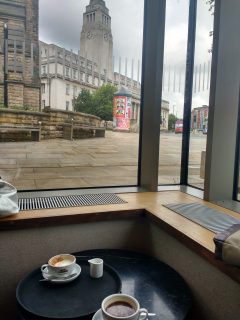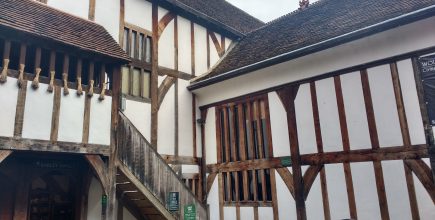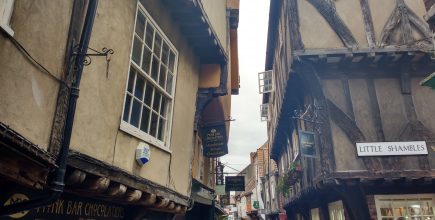01 How to get there
York’s central location makes it one of the most easily reached cities in Britain
York is an elite destination, and it knows it. Not content with welcoming people just the once or twice, the city is out to make a long-term relationship with its visitors. Wherever you live, York’s central location makes it one of the most easily reached cities in Britain, with trains running in from all parts. So the train ought to be your first transport choice.
Stop press: January 2nd, 2018, the Minster (cathedral) tweets – “Big start to the New Year for a big project! After 10 years, 311 panels & an average of 500 hours spent on each – the FINAL panel of the Great East Window is installed!” So another good reason to visit the Minster.
02 What to see and do
Online city
Free public WiFi throughout the city centre has made York one of the best connected tourist destinations in Britain. Anyone armed with a smartphone or tablet may plot a well-informed course around its historic features, using various apps the tourist board and city attractions have created. I particularly like the York Churches app. It helps you discover those quiet little architectural gems, scattered around the city centre like dim stars on the edge of a galaxy dominated by the Minster. Until now many of these fascinating buildings were easily missed down the city’s complicated inner maze of ginnels and snickleways and other narrow mediaeval streets.
The app guides you to St Crux, Pavement, St Denys, Walmgate, St Mary Bishophill Junior and the rest, with information on their history, architecture, decoration and their current use. The city has another high-tech selling point. It’s one of the first places to have its prime tourist attractions filmed by a drone. See them on http://www.visityork.org
Wall to wall attraction
Most visitors leave York railway station and turn left for the short walk to the centre, ideally along the wall in my photo above. On one visit, for a change, I took the nearest stone staircase onto the city walls, straight outside the station, and headed right. Largely intact, York’s ancient defences form a rough square almost 2 miles long, interrupted by the famous gates (or “bars”). Information boards tell a ferocious story, such as: “Richard, Duke of York’s head displayed here”; “Roundheads breach Prince Rupert’s Civil War defences here.” From high on the walls, the views of the city are spectacular and unexpected. The massive Minster dominates every photograph. Complete the full circuit, or walk into the city from any “bar”. I chose Micklegate, via the still-cobbled shop-lined hill down to the first bridge over the river Ouse. So peaceful, and well off the tourist trudge.
Smells nice
Smell is said to be the most direct of our senses, triggering a memory that lasts a lifetime. York is exploiting the power of the nose to communicate some of its many attractions in what they claim is the world’s first scented city guidebook, the Smell York book. Scent engineers synthesised the aromas of horses on York racecourse, steam trains at the railway museum, and gunpowder of the sort the city’s infamous son Guy Fawkes may have used. Open to a photograph and the relevant perfume is released. Other evocative scents of the city include afternoon tea – the aromas of loose leaf teas, spices and cakes, and the tempting scents of cocoa, butter, sugar and nuts used in York’s famous chocolates. The boffins’ biggest quest for olfactory exactitude came in recreating the scents of bad eggs and roses, said to accompany appearances by two of York’s most fragrant phantoms.
Ancient Daze
York is one fat history book of a city. Chapter One is simply wandering around wallowing in the names — High Ousegate, Gillygate, Nessgate, The Shambles (one of the best preserved medieval shopping streets in Europe), Goodramgate, Bitchdaughter Tower, the Stonebow, and Whip-Ma-Whop-Ma-Gate, one of the smallest streets in York. Then visit Jorvik Viking Centre.
And do see the essence of our past railway glory, gently shunted into a great hall a few yards from York station, the National Railway Museum. My favourite among the not-so-frequented places is The Treasurer’s House, the first property to be donated to the National Trust (in 1930 by industrialist Frank Green), complete with all of its contents. His vast collection of art and antiques are shown in 13 rooms, each decorated in the style of a different period. You can still see the metal studs Green placed in the floor to mark the position of furniture.
Barley Hall is a medieval townhouse, and one of the more recent attractions. For decades the original house was hidden under a modern façade; then archaeologists from York Archaeological Trust revealed the wonder it was concealing.
Treasure trove
You needn’t even visit the city to savour the marvels held in the Yorkshire Museum. Keeping up with York’s trailblazing high-tech tourism, it is one of the first to stage online exhibitions in partnership with the Google Cultural Institute. The latest, Yorkshire Hoards, lets you wonder, online, at the Museum’s collection of buried treasures dating from the Bronze Age to the Civil War. One recent online exhibition is “1914: When the World Changed Forever”.
But go to this wonderful museum anyway. You have to see the thrilling York Helmet for yourself. It is the most outstanding object of the Anglo-Saxon period yet found. Its mightily important owner Oshere must have been very proud of it in the 700s AD. And don’t miss the two great auks and the six champion trees in the gardens. www.yorkshiremuseum.org.uk
Steam sensation
The essence of our past railway glory has been gently shunted into a great hall a few yards from York station. Visit the National Railway Museum (free) and I defy you not to go all weak at the knees before the maroon, sumptuously-streamlined Duchess of Hamilton, the new star in the room. Also on show are Flying Scotsman and the last steam loco built by British Railways, Evening Star. These pristine titans keep strange company with the Japanese Bullet Train and a Chinese steam leviathan. On display when I visited was a first-class carriage built in the 1860s, and a Scottish loco that served in France in the First World War. Supporting exhibitions recount the demise of the steam loco, and the trashing of rural rail by Dr Beeching in the 1960s.
Mega minster
York Minster, towering above the city centre, is one of the world’s great cathedrals. They promote some additional features, including a tour of the glaziers’ studio to see mediaeval stained glass being restored, and an exhilarating 275-step climb to the top of the central tower for a view over pinnacles and gargoyles and out across the city’s ancient streets deep into the Yorkshire Wolds. Also open for visits is the octagonal Chapter House from 1286, described as one of the most beautiful rooms ever created. It holds some of the Minster’s finest carvings. It’s a measure of the level of past devotion that there’s an additional walk around 13 churches, all within the city walls.
Old York
Jorvik is the best Viking display outside Scandinavia, and one of our most compelling visitor attractions. It grew out a five years dig at Coppergate in the 1970s. Archaeologists unearthed a fabulous haul of 1000 year old material, well preserved in the damp soil. If you’ve been before, go again, because it’s better still. New in 2010 are some very lifelike animatronic characters, and a rat. Sigurd the antler worker, Unni the woodworker, Viking builders, and an arguing couple talk to visitors in Old Norse. Under your feet, in a new glass-floored gallery, they recreate the original excavation, exposing original timber-framed and wattle houses and objects discarded by residents. Audio-visuals show where the Vikings came from, and how they lived, worked and traded across the world.
York Visitor Guide 2018
03 Places to stay
So many fine hotels so close to the station and the city centre
You don’t need a car to visit York. The main attractions are all tight together and convenient. There is a good choice of hotels a short walk from the railway station. Around the top of the market is the Cedar Court Grand Hotel. They turned the resplendent former neo-Georgian North Eastern Railways headquarters, built by the railway in 1906 near the train station, into the sort of luxury stay the company’s topped-hatted board members would have demanded. It retains the luscious touches of an opulent age of building – from hand-made bricks and Portland stone on the facade, to the lobby’s black and white Belgian marble floors, and the patterned wood blocks and imitation Roman mosaic in the corridors, where clerks once bustled about making the trains run on time.
Only in the lift, where your reflection stretches away to infinity in the all-round mirrors, does the designer reach the 21st century. It’s the classiest form of recycling. This five star hotel retains most of the luscious touches of an opulent age of building. My room, painted in soft pre-war colours, was understated classic elegance.
I have stayed, too, in the Park Inn by Radisson. Our sixth floor room on the river side gave the best view in town of York Minster.
04 Nearby
Powerful cities and dreamy Dales

The Parkinson Building, University of Leeds.
The great industrial city of Leeds could hardly be more different, but it’s a short train journey from York and well worth it, even if you only have time for the City Art Gallery close to the railway station.
The Yorkshire Dales and Wolds are a wonderful attraction to the north and east, and easily accessible. Hull, the 2017 UK City of Culture, is only an hour or so to the east.





